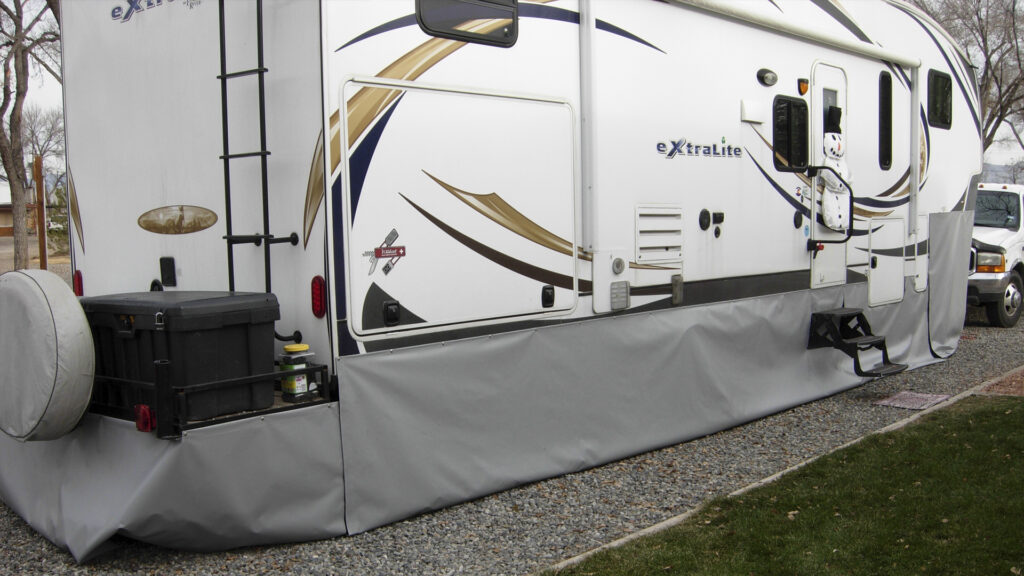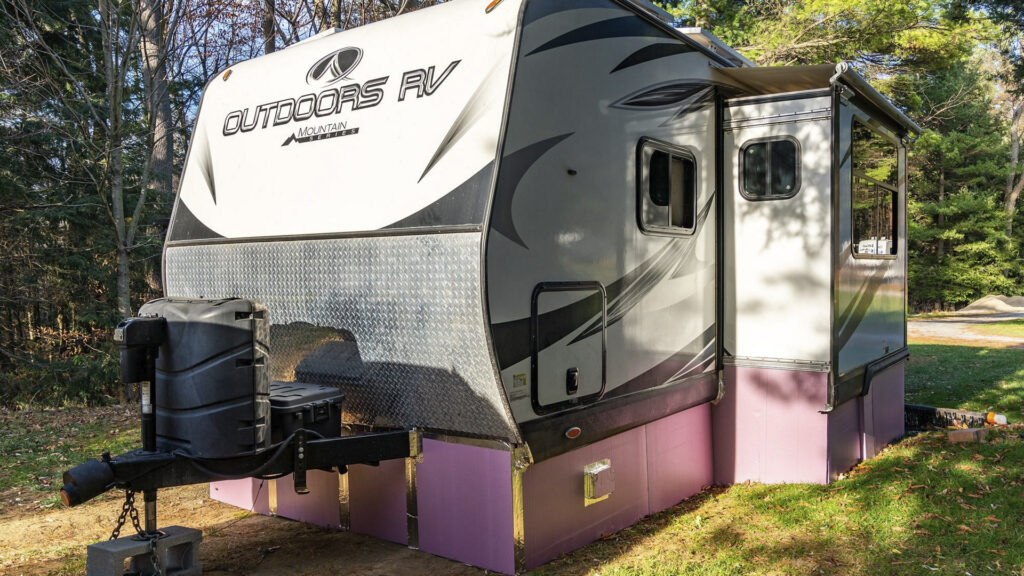
Does RV Skirting Help in The Summer? A Complete Guide
Table of contents
RV skirting is a well-known solution for winter insulation, but does RV skirting help in the summer as well? Many RV owners wonder whether investing in RV weather skirting can keep their camper cooler during hot months. While skirting is primarily used to protect against cold temperatures, it can also play a crucial role in maintaining a comfortable interior temperature when the summer heat is relentless. Managing temperatures in an RV is essential for comfort, energy efficiency, and cost savings. Air conditioning systems can struggle to keep up with extreme heat, leading to high energy consumption and unnecessary wear. This guide will explore how RV under skirting and camper under skirting work in warm weather, the benefits of using them in the summer, and what to use for RV skirting to maximize cooling efficiency.
Understanding RV Skirting
RV skirting is a protective barrier placed around the base of an RV, travel trailer, or fifth wheel. It is designed to enclose the underbelly, providing insulation, energy efficiency, and protection from external elements such as wind, rain, and extreme temperatures.
By enclosing the underside of the RV, skirting helps regulate internal temperatures, keeping the interior cooler in summer and warmer in winter. This reduces strain on heating and cooling systems, leading to lower energy costs and improved comfort. Additionally, skirting minimizes exposure to cold drafts, dust, pests, and road debris, preserving the structural integrity of the RV.
Common RV Skirting Materials
RV weather skirting is typically made from durable, insulating materials such as:
- PVC-coated canvas – Flexible, weather-resistant, and durable
- Vinyl – Affordable, easy to install, and offers moderate insulation
- Foam board – Lightweight, excellent for insulation, but requires extra reinforcement
- Plywood – A sturdy, cost-effective option, though less portable
- Heavy-duty plastic – Water-resistant and durable, but may require additional support
Installation Methods
Installation methods vary depending on the skirting type and material. Common attachment options include:
- Channel systems – Offer a seamless, gap-free barrier for maximum insulation
- Adhesive attachments – Ideal for temporary or seasonal skirting
- Velcro strips – Allows for easy removal and reinstallation
- Snap-on panels – Provide a more permanent, secure fit
How RV Skirting Works in Warm Weather

While RV skirting is commonly used for winter insulation, it also helps keep RVs cool in summer. Here’s how:
- Prevents Heat Transfer – The ground absorbs and radiates heat from the sun, warming the RV’s underbelly. Skirting acts as a protective shield, blocking this heat and reducing overall temperature buildup.
- Traps Cool Air – Because cool air naturally sinks, RV skirting helps contain this cooler air underneath the vehicle, preventing it from escaping. This creates a temperature buffer that helps regulate interior cooling.
- Enhances A/C Efficiency – By minimizing heat transfer from the ground and surrounding air, skirting reduces the workload on the air conditioning system, allowing it to cool the RV more effectively while using less energy. This results in lower electricity consumption and a more comfortable living space.
- Reduces Humidity and Moisture Buildup – During summer, humidity can rise from the ground, leading to excess moisture under the RV. Skirting helps control airflow and reduces the chances of condensation, preventing mold, mildew, and rust.
- Protects Against Pests – In warmer months, small animals and insects may seek shelter under the RV. Skirting creates a barrier that keeps pests out, reducing the risk of unwanted infestations.
- Improves Overall Comfort – By maintaining a more consistent temperature, RV skirting enhances the overall comfort and livability of your RV, making it a must-have for summer camping in hot climates.
Benefits of Using RV Skirting in Summer
Temperature Control
One of the biggest advantages of RV under skirting in the summer is its ability to regulate interior temperatures. By acting as a thermal barrier, skirting minimizes heat transfer from hot pavement or sun-heated ground, keeping the camper’s floor and overall interior cooler.
Energy Savings
A properly skirted camper experiences less temperature fluctuation, which helps improve energy efficiency. With RV weather skirting in place, the air conditioner runs more efficiently, consuming less power and reducing overall cooling costs.
Extended AC Lifespan
Since skirting reduces strain on the air conditioning system, it can extend the lifespan of the AC unit. The average RV air conditioner lasts 3-5 years, and replacement costs range from $1,100 to $3,000. Using camper under skirting to minimize AC overuse can help owners avoid premature replacement expenses.
Additional Storage Space
Skirting also provides a sheltered area underneath, which can be used for storage. Camping gear, bikes, and outdoor furniture can be stored under a camper under skirting setup, keeping them protected from the sun and heat while decluttering the campsite.
Considerations When Using RV Skirting in Summer

Ventilation
While skirting helps keep an RV cool, it’s essential to allow for proper ventilation to prevent moisture buildup. Without adequate airflow, condensation can accumulate, leading to mold and mildew growth. Using breathable materials or incorporating small venting sections can mitigate this issue.
Material Choice
Not all skirting materials are ideal for summer use. Vinyl and PVC are excellent for insulation, but breathable fabric or mesh alternatives allow for airflow while still blocking heat transfer.
Installation and Removal
For summer travelers frequently moving between campsites, ease of installation is a crucial factor. Many modern options feature quick-attach mechanisms, allowing installation in as little as 20-30 minutes. Choosing a product that is easy to set up and remove ensures convenience while on the road.
Additional Tips for Keeping Your RV Cool in Summer
To maximize cooling efficiency alongside camper under skirting, consider these additional strategies:
- Park in shaded areas – Positioning your RV under trees or using natural shade can significantly reduce interior temperatures.
- Use reflective window coverings – Products like Reflectix help block heat from entering through windows.
- Insulate skylights – Skylights can let in significant heat; using insulation covers like AirLights can minimize this effect.
- Limit door openings – Keeping doors closed as much as possible prevents cool air from escaping.
- Utilize awnings and shade structures – Outdoor shade solutions help block direct sunlight, keeping the RV exterior cooler.
While traditionally used for winter insulation, RV weather skirting plays a crucial role in maintaining a cooler RV interior during hot months. By reducing heat transfer, improving air conditioning efficiency, and even providing additional storage, RV under skirting is a valuable investment for year-round comfort.
Stay Cool & Save: The Ultimate RV Skirting Solution for Summer!
Beat the summer heat and keep your RV cool with Custom Skirting, the nation’s #1 RV skirting solution! Our precision-tailored, on-site installation ensures a perfect fit, sealing out heat and reducing A/C costs. Unlike traditional skirting, our exclusive “No-Snap, No-Gap” channel system blocks hot air while providing unmatched insulation for year-round comfort.
Don’t settle for less—enhance your RV’s efficiency and comfort today!
Get Custom Skirting Now!
